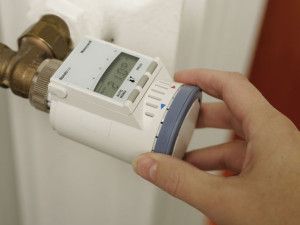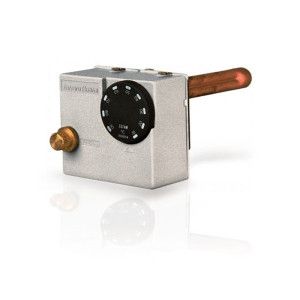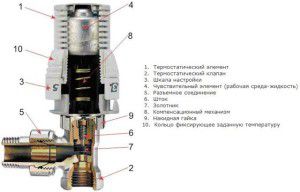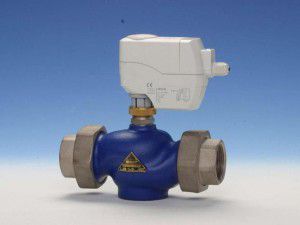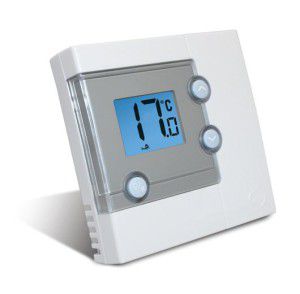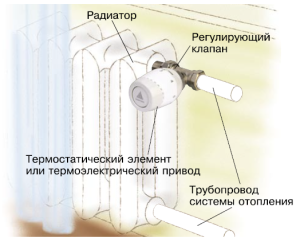The operation of the heating system will be effective only if there are control elements. With their help, it is possible to regulate the coolant flows, thereby controlling the temperature in individual circuits and the entire highway as a whole. Best of all, thermostats for heating systems: boiler, pump, battery, radiator, cope with this task.
Functionality of thermostats
In most cases, during heat supply operation, an uneven distribution of heat is observed in radiators and tubes. This is due to its cooling down while moving along the transport highways. For stabilization and timely adjustment, room thermostats for heating are installed.
Their task is to limit the influx of hot water into a specific heating element - a separate circuit, radiator or battery. Structurally, they consist of a locking part (valve-stem) and a control component. An installed thermostat for a battery or a separate heating circuit improves the following system parameters:
- Radiator heating degree control. By regulating the flow of hot water, the temperature on the surface of the heater changes;
- Optimization of heating medium heating costs. The laid on thermostat for heating reduces the cost of heating hot water, reducing the difference in temperature between the supply and return pipes;
- Heating automation. Almost all models of thermoregulating devices work offline. It is important to initially set the initial operating parameters correctly.
What is the difference between a thermostat for a heating boiler and a similar model for a radiator or a circulation pump? First of all, the response speed of the control element and the temperature mode of operation. Therefore, it is recommended to select the optimal model for each heating component. And for this, their types and design features should be considered.
Any thermostat for heating a house has individual operating parameters - a feature of the installation, the degree of temperature regulation, etc. They must correspond to the characteristics of the heating element on which the appliance will be installed.
Types of thermostats
The installation location and characteristics of the thermostat are determined during the design of the heating system. Calculation of the heat supply parameters is preliminarily performed and, based on these data, the system components are selected.
The thermostat on the radiator in this case is no exception. But in addition to technical qualities, operational ones should be taken into account. These include the following factors:
- The degree of automation of the device. It determines how often manual tuning is needed for normal operation;
- Installation Features. Some models of room thermostats for heating can be mounted in a strictly defined position;
- Control accuracy. What changes in the temperature of hot water will trigger the device;
- Additional modes. Almost every electric thermostat for heating can be configured for daily or weekly operation according to strictly defined system parameters.
Consider the most common types of thermostats for heating a house, depending on the design features and performance.
Some boiler models already have built-in thermostats. This must be taken into account when designing the adjusting mechanisms of the heating system.
Mechanical thermostat for heating
The easiest way to control the heating of the radiator or part of the system is to purchase a mechanical thermostat for heating boilers, which can also be installed in the radiator harness. Its design is not particularly difficult. It includes a locking mechanism and a mechanical control unit.
Under the influence of temperature, the working element expands, which is filled with a working fluid. Its body begins to put pressure on the rod, which, falling, restricts the flow of hot water in the pipe. Reducing the working diameter of the line leads to a decrease in heating of the radiator.
Such thermostats in the heating system can be installed only after familiarizing themselves with their features:
- Place of installation. It can be installed on both the inlet and outlet pipe. It all depends on the task. If it is necessary to adjust the degree of heating of the radiator, installation is carried out in front of it. To limit the flow of coolant from the battery, it is mounted after it;
- Location For correct operation, the thermostat on the heating battery must be installed on the side so that hot air does not affect the control element;
- Pre-calculated thermostat parameters for a specific heating system.
The defining characteristic of mechanical thermostats for heating boilers is their throughput.
The control element is set before the heating system starts. To do this, it is necessary to stabilize the pressure in the pipes and set the required thermostat response value for the heating boiler.
Two and three way valves
These are universal devices that can perform several functions. Their difference from the above-considered thermostats for a heating radiator is the absence of a control component operating from changes in water temperature.
A simple mechanical thermostat for heating boilers only works in the local area. Those. In fact, the temperature indoors and outdoors is not taken into account. Automated valves do not have this drawback. This is due to the features of their design, which consists of the following components:
- Mechanical valve - crane;
- Servo mechanism mounted on the control rod of the crane.
The servo mechanism can be connected to any external control element - a programmer or temperature sensor. Depending on the external data, the valve stem is adjusted, which limits the flow of coolant in this section of the highway.
In addition to the thermostat function on the radiator, the valves can be used in the following heating elements:
- Water floor heating. They are part of the mixing unit;
- Collector heating system. Regulate the flow of coolant to a specific section of the highway.
If you need a thermostat for the heating pump, two and three-way valves will be the best option. In addition to the function of adjusting the volume of hot water, in some cases they can stabilize the hydrodynamic distribution in the system.
Some valve models have a built-in temperature sensor and at the same time have the ability to connect to an external thermometer.
Electronic thermostat for heating
To automate the operation of heat supply, it is recommended that an electronic overhead thermostat be installed for heating. Often they are not mounted on a battery or radiator, but have a remote design. It can be installed anywhere in the room.
The simplest models of room heating thermostats have one remote temperature sensor and a control element. It is installed in a specific area of the system and, according to its indications, the parameters of the boiler or control valve change.However, for efficient operation, it is recommended to use more complex models of overhead thermostats for heating with the programmer functions - daily or weekly.
To select a thermostat for a heating battery, you should first familiarize yourself with their types:
- With bimetallic spiral. When exposed to hot air, it expands and closes the contact. As a result of this, the adjustment mechanism is triggered and a signal is sent to open (close) the valve. The mercury sensor performs the same functions;
- With timer. This is an additional component that can be configured to change the heating parameters depending on the time of day. This thermostat is suitable for heating a small house;
- Programmable. In these models, the mechanical part is connected to the electronic control unit.
The last type of electric thermostat for heating is convenient for organizing autonomous heat supply. It can be connected to several components - a boiler, servomechanisms on radiators and a circulation pump.
After installing the thermostat for the heating pump, it must be calibrated. Actual data from the thermometer of the pressure gauge is verified with the readings of the device.
Features of the use of thermostats
However, it is not enough to choose a thermostat for a heating boiler or battery - you need to install it correctly. Depending on the type of device, there are various wiring diagrams. It is best to read the instructions for use from the manufacturer of the competitive model.
There are several standard installation methods that may vary slightly. Consider each of them, depending on the specific heating element.
Thermostats for radiators
To mount the thermostat on a heating radiator, you must first drain all the water in this heating area. Then the device is installed between the battery and the inlet pipe. It is important to check the correct position of the thermostat - on its body the direction of movement of the coolant is indicated.
After installing the thermostats in the heating system, they are checked for their operability. To do this, it is necessary to fill the system and heat the coolant to the optimum level. Then the device is installed in various thermal conditions. At the same time, the degree of heating of the radiator is checked using an overhead or built-in thermometer.
Thermostats for heating boilers
For boilers, it is recommended to use electric thermostats for heating. They are connected to the control unit of the equipment. Depending on the temperature in the room or on the street, the thermostat gives a command to change the degree of heating of the coolant.
The main difficulty lies in the correct selection of terminals for connecting these devices into a single control circuit. This data can be taken from the connection instructions. For mechanical thermostats installed in heating boilers, the installation process is no different from the radiator circuit.
Thermostats for circulation pumps
Almost all thermostats for circulation heating pumps are electronic. They are connected to the control unit and change the speed of rotation of the impeller depending on the readings of external sensors.
An important factor when choosing is the cost of the thermostat. Therefore, it is recommended first to conduct a preliminary analysis of offers on the market.
| Model | A type | price, rub. |
| FANTINI COSMI Therm C 16 | Mechanical | 560 |
| Zoom WT 100RF | Wireless electronic | 3380 |
| Computherm Q7 RF | Radio controlled | 3250 |
| RT-01B ANIA (TRT01B) | Electronic for boilers | 7030 |
What else to consider when choosing a thermostat? First of all, its functional features. To automate the heating system, we recommend purchasing a model with GPS control.In this way, you can remotely receive readings from the heat supply of the house and manage its parameters.
Familiarization with the video material will help to understand the principle of operation of room thermostats in heating:
